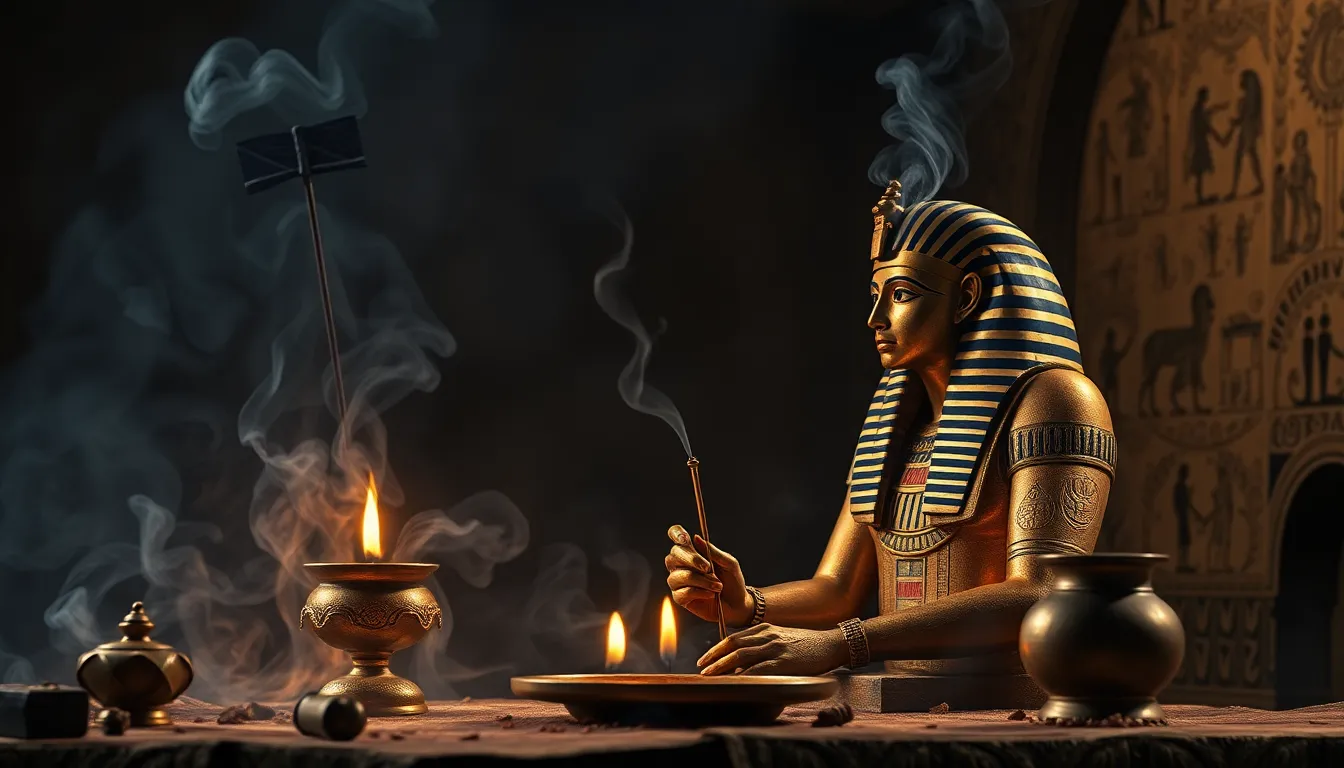The Use of Incense in Ancient Egyptian Rituals
I. Introduction
Incense is a substance that releases fragrant smoke when burned, and it has played a significant role in spiritual and cultural practices throughout history. In ancient Egyptian culture, incense was not only used for its aromatic qualities but also held deep spiritual and religious significance. This article aims to explore the multifaceted use of incense in ancient Egyptian rituals, providing insights into its historical context, types, spiritual importance, and lasting legacy.
II. Historical Context of Incense in Ancient Egypt
The origins of incense can be traced back to ancient civilizations where it was used for various purposes, including religious rituals, medicinal practices, and as a part of daily life. In Egypt, the introduction of incense into rituals is believed to have occurred around the time of the Early Dynastic Period (c. 3100–2686 BCE), influenced by trade with neighboring regions that valued aromatic substances.
Key periods that influenced incense use in Egypt include:
- The Old Kingdom, where the construction of temples and tombs led to increased ritualistic practices.
- The Middle Kingdom, during which incense became a prominent element in funerary rites.
- The New Kingdom, when extensive trade routes were established, allowing for the import of a wide variety of incense materials.
III. Types of Incense Used in Ancient Egypt
Ancient Egyptians utilized various types of incense, primarily derived from resins, gums, and other aromatic substances. The most commonly used incense types included:
A. Commonly used resins and substances
- Frankincense: Obtained from the Boswellia tree, it was highly valued for its fragrant smoke and was often used in religious ceremonies.
- Myrrh: Derived from the Commiphora tree, myrrh was used in perfumes and as an offering to the gods.
- Other aromatic substances: This included spices such as cinnamon, and other resins, which were sometimes combined for ceremonial use.
B. Sources and trade of incense materials
The trade of incense materials was a significant aspect of ancient Egyptian economy and culture. Incense was often imported from regions such as:
- Somalia
- Arabia
- East Africa
These trade routes allowed for a rich diversity of incense types to be available for both religious and domestic purposes.
IV. Spiritual Significance of Incense
In ancient Egyptian rituals, incense played a crucial role in connecting the physical world with the divine. Its smoke was believed to carry prayers and offerings to the gods, thus enhancing the spiritual atmosphere of ceremonies.
A. Role of incense in religious ceremonies
During religious ceremonies, incense was burned to purify the space and create a pleasing aroma that attracted the gods. It was commonly used in:
- Daily temple rituals
- Festivals honoring deities
- Private offerings by individuals
B. Symbolism associated with different types of incense
Each type of incense held its own symbolism. For example:
- Frankincense symbolized divinity and was associated with the sun god Ra.
- Myrrh represented purification and was often linked to the afterlife.
C. Connection between incense and the divine
The act of burning incense was seen as a sacred duty, reinforcing the belief that the smoke carried the prayers of the faithful directly to the gods.
V. Incense in Daily Life and Domestic Rituals
Beyond its use in grand religious ceremonies, incense played a significant role in daily life and domestic rituals of the ancient Egyptians.
A. Use of incense in homes and personal worship
In households, incense was commonly burned during personal worship or family gatherings, creating a sense of sanctity and inviting divine presence into the home.
B. Incense in funerary practices and burial rituals
Incense was also integral to funerary practices, where it was burned to honor the deceased and accompany them in their journey to the afterlife. It was believed to ward off evil spirits and purify the space of the dead.
C. Impact of incense on social and cultural practices
The use of incense extended to social and cultural practices, with its aromatic qualities often incorporated into celebrations, healing rituals, and even daily relaxation practices.
VI. The Process of Incense Preparation and Use
The preparation and use of incense involved specific methods and rituals that were carefully observed by priests and practitioners.
A. Methods of preparing and burning incense
Incense was typically prepared by grinding resins and mixing them with other substances. The burning process involved:
- Creating small cones or sticks of incense.
- Using charcoal or open flames to ignite the incense.
B. Tools and equipment used in incense rituals
Rituals often required specific tools, including:
- Incense burners made of clay or metal.
- Scoops and mortars for grinding resins.
- Altar spaces dedicated to offerings and incense burning.
C. Ritualistic practices surrounding incense use
Rituals surrounding incense use included prayers, songs, and dances to enhance the spiritual experience and foster a connection with the divine.
VII. Legacy of Incense in Ancient Egyptian Culture
The significance of incense in ancient Egyptian culture has left a lasting legacy that can still be observed today.
A. Influence on later cultures and religions
Incense has influenced various cultures and religions throughout history, appearing in the practices of the Greeks, Romans, and even in modern religious ceremonies across different faiths.
B. Continued relevance of incense in modern practices
Today, incense continues to be used in spiritual and meditation practices around the world, signifying its enduring connection to the divine.
C. Archaeological findings related to incense use
Archaeological excavations have uncovered incense burners, remnants of incense materials, and inscriptions detailing its use, providing insight into the rituals of ancient Egyptians.
VIII. Conclusion
In summary, the use of incense in ancient Egyptian rituals was a profound aspect of their culture, representing a link between the earthly and the divine. Its historical context, types, and spiritual significance reveal much about the beliefs and practices of the ancient Egyptians. As we reflect on the enduring significance of incense in spirituality, we invite further exploration of ancient Egyptian rituals and their influence on modern practices.




